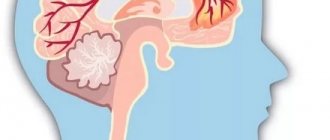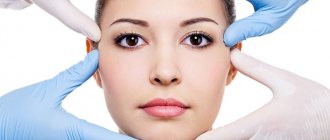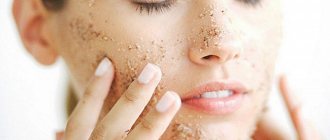Why does redness occur on the face?
The skin is the largest organ of the human body: its area ranges from 1.5–2.3 m2. It is a durable multi-layer elastic cover that performs a huge number of functions. Among them:
- protection of internal organs from damage, penetration of microorganisms, chemicals;
- preventing dehydration;
- participation in breathing, thermoregulation, metabolic processes;
- touch through nerve endings;
- removal from the body in sweat of toxins and waste products of the body (excess salts, ammonia, urea);
- secretion of sebum (secretory function), which ensures the elasticity of the epidermis and creates a protective environment on its surface;
- participation in the production of vitamin D.
The skin consists of three layers - epidermis, dermis and hypodermis. The epidermis is the upper layer visible to the eye, consisting of five layers. Its thickness ranges from 0.5 mm on the eyelids to 1.5 mm on the palms. The cells of the lower layer of the epidermis continuously divide, responsible for the rapid renewal, restoration, and healing of the skin. After division they begin to move upward.
As you progress, the amount of keratin and other dense proteins in the skin cells increases, and the division process slows down. The top layer consists of dead, keratinized cells that are continuously exfoliated. Using this method, the skin of an adult is completely renewed within two months, and in a baby – in three days.
The middle layer is the dermis, with a thickness of 0.3 to 3 mm. It consists of connective tissue containing collagen, muscle fibers, and nerve endings. Veins, arteries, and capillaries run through this layer, through which nutrients enter the blood. This method provides nutrition not only to the dermis, but also to the epidermis, where there are no blood vessels.
The lowest layer is the hypodermis, known as subcutaneous fat. Its task is to protect internal organs from external damage. The thickness of the hypodermis ranges from 2 mm on the head to 10 cm on the buttocks. There are many vessels, nerve endings, sweat glands, ducts of the sebaceous glands, hair follicles (the place where hair originates).
The main causes of redness on the face are inflammation and dilation of blood vessels in the dermis or hypodermis under the influence of external or internal causes. Because of this, they begin to appear through the epidermis, giving the skin a red color. The color can range from pinkish to raspberry-burgundy, depending on the thickness of the top layer of skin and the reason that caused the color change. These can be both physiological and pathological factors.
Tea
With him everything is much more interesting and complicated than with a stuffy bus.
When we drink hot tea, we heat up the veins in our neck. The jugular vein runs next to the carotid artery and also heats it. The carotid artery very quickly delivers heated blood to the brain, and it decides that the person is overheated. To increase heat transfer, the brain causes blood vessels to dilate and increases sweating.
In order not to scare others with a red face while drinking tea, you need to cool it slightly before drinking tea. Or cool your neck slightly by eating something cold. Then this reflex will be interrupted.
Causes of facial redness
Wind, low temperature, smoking, alcoholic drinks, stress, hard work, vigorous massage - these are the physiological causes of redness. They are a normal response of the body to the influence of factors unfavorable to the epidermis and subcutaneous vessels. Unlike pathological causes, they are never accompanied by dryness, itching, or peeling; nevertheless, a burning sensation may appear: for example, when a person finds himself in a warm room after a severe frost.
- What's fashionable in men's clothing right now?
- The funniest surnames in Russia and in the world
- How to cook eggplants with tomatoes and garlic in a frying pan
The causes of pathological redness include situations that cannot be explained by the natural nature of their origin, since they provoke the development of reactions in the skin that are characteristic of inflammatory processes. This condition may be accompanied by burning, itching, peeling and other unpleasant sensations. Pathological redness on the face can be caused by the following reasons:
- allergy;
- infection;
- inflammation;
- vascular pathologies;
- diseases of internal organs;
- mental illness.
It is not always easy to distinguish the physiological nature of redness from the pathological one. You can focus on the following symptoms:
- With physiological redness, the colored area does not have a clear boundary. The redness simultaneously covers the cheeks, nose, forehead, chin, gradually turning into a natural color. If the cause is a mechanical effect (rubbing the skin in a certain area), only the area subjected to stress turns red.
- With pathological redness, the colored area has smooth boundaries and often covers a certain area (only the nose, cheeks, etc.). At first, the color is slightly pronounced, over time it acquires a more intense color, does not go away until the provoking factor is eliminated, but even after this, traces may remain.
- With a physiological nature, the skin turns red quickly, the severity of the color does not increase. When the effect of the provoking factor ends, the redness disappears without a trace, without causing negative consequences.
Physical factors
There are many reasons not related to pathological processes in the body that can provoke temporary dilation of blood vessels on the face. These include:
- external temperature - cold, heat, ice or hot water;
- strong wind;
- intense friction - massage, rubbing, vigorous rubbing of cream, scrub, and other cosmetics;
- sunburn;
- prolonged exposure to dust on the skin;
- strenuous work or vigorous exercise;
- long stay in a position where the head is below the waist (weeding cities);
- injuries, burns.

Psycho-emotional
Expansion of blood vessels can be provoked by psycho-emotional factors. It can be:
- any strong feelings - fear, shame, joy, excitement, emotional stress, joy;
- anxiety before important events (speaking in front of an audience, interview, important conversation);
- stress;
- depression;
- feeling of self-doubt;
- complexes, fears, psychological barriers.
Blushing syndrome may develop under the influence of exciting or stressful factors. This condition is characterized by redness of the face in any exciting circumstances. Redness covers the skin in spots and does not go away for a long time. In such situations, a person often feels discomfort because he understands that his anxiety is noticeable to others. The cause of blushing syndrome is the overactive functioning of the sympathetic nervous system, which causes the blood vessels on the face to dilate not only in severe stressful situations, but also in slight excitement.
Medications for blushing syndrome are ineffective because they are unable to affect the ability of the sympathetic nervous system to respond to various factors. Treatment in this case involves surgery: during the procedure, a clip is applied to the nerve through which the brain orders the vessels of the face to expand, or it is even cut. The method is effective in 95% of cases.

Allergic reaction
Vasodilation can provoke an allergic reaction. This is the name given to the immune system’s response to a specific irritant (allergen), which it perceived as a threat to the health and life of the owner. Anything can provoke such a reaction:
- pollen, fluff;
- dust mites, cockroaches;
- pet hair;
- mold;
- medicines;
- food products - nuts, eggs, seafood, milk, legumes, citrus fruits, etc.;
- insect bites.
Among the manifestations of allergies are redness of the facial skin, accompanied by itching and swelling. A symptom of an allergic reaction is dermatitis - inflammation of the skin, manifested by a rash, pimples, blisters, pustules (pustules), cracks through which infection can easily penetrate. Allergies are dangerous because they rarely go away on their own, and if the allergen is not eliminated, it can cause anaphylactic shock and death. As soon as the irritant is eliminated, the allergic reaction disappears, the redness completely disappears.
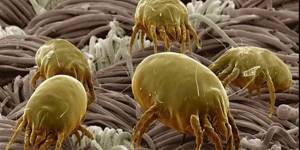
Infectious diseases
Redness of the skin on the face in women can be caused by infectious diseases. Among them:
- Cold or flu. Under the influence of high temperature, the blood vessels dilate, which leads to the appearance of a blush;
- Demodecosis. Chronic disease with periods of exacerbation. It is characterized by the penetration of a tick into the skin, the waste products of which lead to an allergic reaction. Demodicosis is manifested by itching, swelling, redness of the eyelids, and the appearance of scales around the eyelashes.
- Erysipelas or erysipelas. The reason is the penetration of beta-hemolytic streptococcus group A under the skin. The onset of the disease is acute, the symptoms of intoxication are pronounced - migraine, weakness, chills, nausea, high fever, swelling and thickening of the skin. Complications include necrosis and ulcers. The disease is prone to relapse, especially if left untreated. Treatment of the disease involves the use of antibiotics.
- Acne vulgaris or acne. Chronic inflammation of the skin, during which the sebaceous glands at the base of the hair follicle become blocked, which leads to the formation of comedones in the form of black and white formations, pustules, and redness at the site of inflammation.
- Fungal infections. Among them are trichophytosis and microsporia, collectively known as ringworm. Trichophytosis is characterized by reddish round spots that are very itchy and itchy, affecting the hair roots, which causes baldness. A symptom of microsporia is round or oval, clearly defined red spots with peeling. The fungus also affects hair, eyebrows, and eyelashes, causing the hair shafts to break off at a height of 5-6 mm.
- Measles, scarlet fever, chickenpox are acute infectious diseases characterized by high fever and a red itchy rash.

Inflammatory processes
The cause of redness may be inflammation, which develops after the immune system reacts to the penetration of a certain parasite into the body and sends white blood cells to destroy it. If immune cells cannot cope with the pathogen, they die, forming pus, attracting new leukocytes to the site of the lesion. Various situations can provoke inflammation on the face. Among them:
- Reaction to low-quality or incorrectly selected cosmetics.
- Skin contact with chemicals.
- Acne.
- Skin diseases - psoriasis, dermatitis, eczema.
- Photosensitivity is increased sensitivity to ultraviolet radiation caused by medications, laser hair removal, or other procedures. When the skin is exposed to sunlight, inflammation develops, accompanied by redness, swelling, and itching. After stopping the medication, the body stops reacting to the sun.
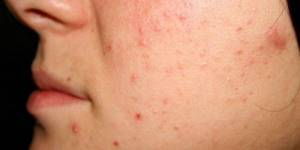
Pathologies of internal organs
In diseases of the internal organs, redness is often permanent and does not disappear until complete healing. In this situation, dilation of capillaries is a symptom of pathology, and to eliminate it it is necessary to treat the underlying disease. The complexion can be either pinkish or dark cherry, depending on the stage of the disease. Changes in skin color can provoke the following pathologies:
- high body temperature, regardless of the cause of facial redness in women, men, children;
- menopause;
- diabetes;
- atherosclerosis (deposition of cholesterol plaques on the walls of blood vessels);
- hypertension, heart failure, other pathologies associated with myocardial function;
- low acidity of gastric juice;
- frequent constipation;
- trigeminal nerve injury;
- medication use;
- chronic diseases of the ear, nose and throat (rhinitis, sinusitis, etc.);
- gynecological problems;
- parasitic diseases;
- problems of the digestive tract (cholecystitis, gastritis, kidney failure, cirrhosis);
- alcohol and drug poisoning;
- autoimmune diseases (systemic lupus erythematosus);
- erythrocytosis (pathological increase in red blood cells in the blood).
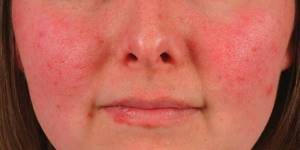
- 6 ways to curl medium length hair
- How to find out a mobile operator by phone number
- Cabbage casserole: recipes with photos
Vessels
Vascular diseases can provoke redness, among them rosacea. It is characterized by the high sensitivity of blood vessels to changes in temperature, wind, heat, cold and other environmental factors that negatively affect the epidermis. In response to such exposure, the skin turns very red, the color remains for a long time even after getting into comfortable conditions, and is accompanied by a burning sensation. With rosacea, rosacea may appear, and thickening of the nose with the formation of nodules (papules) or bumps may occur.
The cause of persistent redness is rosacea, characterized by dilation of the blood vessels of the skin, which causes their elasticity to be lost. The capillaries are clearly visible in the form of a mesh. The pathology can be triggered by a long stay on the street under unfavorable conditions (working in winter) or internal pathologies, including hypertension, cirrhosis, gastritis.
Rosacea and rosacea are not the only vascular pathologies that can cause redness. It is worth highlighting such diseases as:
- skin hemangioma is a benign tumor of blood vessels, often manifests itself in the form of a node of capillaries closely adjacent to each other, and can protrude above the surface of the epidermis;
- Kasabach-Meritt syndrome - occurs in the first year of life, characterized by hemangiomas, anemia, and a low platelet count;
- Klippel-Trenaunay-Weber syndrome is a hereditary disease accompanied by a birthmark, hypertrophy of bones and soft tissues, varicose veins;
- Osler-Rendu disease is a hereditary pathology characterized by numerous spider veins on the face that bleed;
- Louis-Bar syndrome - manifested by capillary “stars”, impaired coordination, low immunity.

How to use algaecide when the pool water turns red
In normal situations, a 10% solution is applied to the previously cleaned pool walls, seams, corners, sides and floor to completely destroy these microorganisms, and only after that the pool is filled with water, the pH of which is adjusted to 7.4. Shock chlorination must be carried out and a certain amount of algaecide is added as a starting treatment when filtration is turned on. This procedure is recommended to be carried out once a week.
In a situation of urgent need (the water is already red), in order to carry out emergency control of algae and other microflora, shock treatment should be carried out with an increased dosage, which is specified in the instructions.
To prevent red water from appearing in the pool
, and the question did not arise - why the water in it turns red; it is necessary to carefully monitor its quality and use effective means for caring for the pool. The main components of water treatment can be considered:
- water filtration and circulation;
- treatment with special chemicals.
—
Filtration and circulation of water in the pool alone is absolutely not enough for water purification. To prevent the proliferation of microorganisms, algae, viruses, fungi and bacteria, disinfection is necessary using algaecides and coagulants, which help to effectively eliminate turbidity and color of water, as well as filter out the smallest particles, which are a good environment for the proliferation of microorganisms. That is, it is impossible to refuse the use of effective chemicals in swimming pools.
Bodies of water across the globe are reportedly turning the color of blood, causing fear among the general public. People think that the end of times is approaching.
From sea to river, numerous bodies of water turn the color of blood throughout the night. Astonishing images of the incidents are surfacing on social media. A number of different groups point to the Bible prophecy of Revelation 16:4. Yet is there any other explanation for the unusual phenomena other than the impending apocalypse?
Recently, many reports indicate that seas around the globe are turning red. For example, The Washington Post reported one such incident in China. It happened on a river in the city of Wenzhou. Residents say they woke up to a strange sight of red water. There was no explanation for the phenomenon.
“Several people who were on the river at about 5 a.m. said everything was fine, but then suddenly within a few minutes the water began to darken and eventually turned completely red.”
Wenzhou is the center of the Christian faith and many call it the Jerusalem of China. Some residents after the event pointed to a prophecy from the Christian Bible to explain the strange bloody waters. While many believed the red river was a sign from heaven, the Chinese government says there is a simple explanation for the red waters. The local environmental department says tests show the water is an alarming shade of red due to illegal dumping. Probably artificial dyes from the clothing industry.
The Telegraph reported another strange incident that led to the closure of Sydney beaches in Australia. Tourists in the area initially feared that the blood was the result of a shark attack, but no such attack occurred. In fact, local officials noted that the blood red color was the result of an algae bloom in the area. Beaches were closed and several photos of the strange waters began circulating online.
According to the BBC, residents of the Pacific islands of Tonga were also surprised by the blood-red color of the seas. As in China, many in the region immediately began to fear that red tides were a sign of the end of times. However, as on Australian beaches, red tides have been attributed to red algae blooms. In fact, the same red tides occur once a year along the Florida Gulf Coast.
Although the strange phenomena have been attributed to illegal dumping of industrial waste and excessive red algae blooms in seas around the world, rumors continue to circulate on the Internet. And believers say that the end of times is approaching.
Something like this kind of message can be found everywhere on the Internet: “THE WATER has turned blood red - Wake up!!! Folks, we see before us omens from the Book of Revelations. The highest court on Earth is approaching!!! Waters around the world are turning blood red!!! "
What do you think? Are you worried that bodies of water around the globe are turning blood red?
The Bible says that the rivers will become red as blood (Rev. 8:6-13), apparently this time has come. From 2010 to the present day, the water has deteriorated, disappearing in places, and sometimes turning red like blood. This process has already begun in many countries of the world: the USA, Antarctica, Australia, Iraq, China, Iran, Russia, etc.
The glaciers are melting, and red water pours out of them; a beautiful forest - and a river flows in it, terrible as blood. In television programs they either don’t talk about this or mention it casually, in passing. Probably so that people don’t know anything and, therefore, don’t understand that, apparently, the Apocalypse has really begun. And there is only time left for repentance to our Lord God, as well as for strengthening in faith before the terrible persecution of all Christians by the Antichrist, but not for various entertainments. If only many knew the truth about what is happening now (the planned introduction of plastic passports (after the adoption of which, as the elders prophesied, there is no turning back, but only the road to destruction!) and microchipping of the population, with the upcoming electronic concentration camp; which has appeared in different parts light red and strange water (see also); revealed apostasy in faith, apostasy, and the “fearfulness” of some bishops and priests, who, instead of standing firmly in the truth, are more afraid of the rulers of “this world” and even reject the very idea of restoration in Russia the power of the King - the Anointed of God; the construction of a single anti-Christ religion; the emergence of the monstrous; the earthquake that happened on Mount Athos and the growing cataclysms throughout the Earth; psychotronic radiation of HAARP; LHC and much more), and most importantly, they would realize the connection between all these events! Almost all of this is the work of not so much human hands as the Prince of Darkness himself, realized through the servants of the coming Antichrist. Understanding this, perhaps many would finally come to ardent faith and deep repentance, which can only hinder the growing changes in the world. But, knowing nothing, they continue to live in stupefied peace and idle complacency - to the endless “serials”, television concerts and the clumsy or extremely cynical “humor” of “Crooked Mirrors” and “Comedy Clubs”!
As one person wrote on the website of the Pochaev Lavra, “it’s painful to look at all this, your heart hurts, your soul worries, you just want to shout: “People, wake up!!! Stop sitting in front of the TV and becoming a zombie. Don’t laugh and don’t say that this is all nonsense and fairy tales; There is very little time left, repent while you still have it! Repent! Go to churches, confess and receive communion while it’s still possible!!!” You talk to many people and are surprised: after all, many still don’t know anything about plastic passports and the laser mark on the forehead that accompanies their receipt, or they think that this is still far away - it won’t happen soon; they know nothing about juvenile justice; they don’t know or suspect much. This is such a sad state of affairs, I want to cry - how can I make people understand? We need to tell as much as possible, maybe at least someone else will think about it, understand and be saved. God willing!” These are such heartfelt words... By the way, the youth Vyacheslav Krasheninnikov also spoke about the fact that the water will become thick and red, like blood, and will emit a stench, and it will be possible to drink it with great difficulty only after repeated boiling.
Red water in Henan.
Red water in Henan.
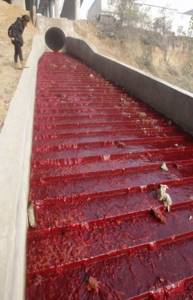
Red water in Henan.
In the Black Sea near Sevastopol, the water near the shore turned red. In addition, dead fish are floating in Cossack Bay.
Vacationers are scared and afraid to swim in the strange water.
Even the old-timers don’t remember anything like this. In Cossack Bay, the water near the shore is red, and dead fish swim at the very edge.
“I went in for a dip, and there were some pink clumps,” Andrei, who came to relax on the beach with friends, told KP. “The color of the water didn’t scare me—on the contrary, I became curious what it was, so I climbed into the red waves. The water was cold, 18 degrees, although the other day the sea was +23...25°. And at a depth of three meters my legs actually cramped, there the temperature was still a couple of degrees lower. No itching or irritation on the skin, normal weight.
Other vacationers did not dare swim in the “red” sea.
The townspeople are alarmed: what if oil has spilled somewhere nearby? However, scientists explain this differently (well, they, as always, will find “explanations” - ed.)
Most likely, the sea turned red because of dinophyte algae,” Lyudmila Kuzmenko, candidate of biological sciences at the Institute of Biology of the Southern Seas, told KP. “They bloom due to a sharp change in water temperature. To find out if this algae
, you need to take a water sample. Red tides are the most dangerous for fish - they die because there is a lack of oxygen in the water.
According to Lyudmila Viktorovna, toxins released into the water by algae can accumulate in the bodies of fish and shellfish. If you eat them later, you can get poisoned...
A beautiful and neat appearance attracts people, brings good luck and helps maintain a good mood. Therefore, every person takes care of the condition of their hair, nails and looks after their skin.
Daily washing and routine hygiene procedures that help keep the body clean can sometimes cause facial redness.
Types of redness on the face
The shape of spots on the face largely depends on the reason that provoked the change in skin color. It could be:
- Redness on the forehead and cheeks, gradually turning into the natural color of the skin, is characterized by rapid disappearance in comfortable conditions. Provoked by physiological reasons.
- Inflammation accompanied by acne.
- A soap rash is a symptom of an allergy.
- Exudative form - spots of various shapes appear on the skin, in place of which bubbles and ulcers form. The formations itch, hurt, and are often accompanied by fever. The reason for their appearance is viruses, staphylococci, streptococci, and sometimes antibiotics and anticonvulsants.
- The nodular form is red rashes in the form of dense, round, painful formations. Sizes range from small rashes to large formations, up to 10 cm in diameter. The reason is viruses.
- Ring-shaped - spots of different sizes with a clearly colored edge. Signals a bacterial or fungal infection, allergy or autoimmune disease.
- Migratory form. The spots occur where ticks or insects have bitten them if they carry diseases (such as Lyme). After some time, the irritation may move away from the bite site, growing in size. If you find such a spot, you should urgently consult a doctor.
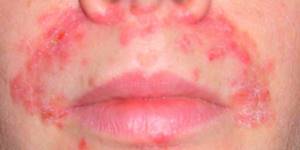
Accompanying symptoms
Red spots are often accompanied by symptoms that help determine the cause of the change in complexion. It can be:
- Peeling. Signals increased sensitivity to weather conditions, low-quality cosmetics, and vitamin deficiency. It occurs with demodicosis, fungal and skin diseases, and damage to internal organs.
- Itching. A symptom characteristic of allergic reactions. Accompanies measles, rubella, scarlet fever. If it is combined with peeling, dryness or lasts more than 20 days, it indicates a skin disease.
- Burning. It happens with allergies, rosacea, it develops during a long stay in conditions unfavorable for the skin, due to a sharp dilation of blood vessels, a long stay with the head bowed low, after strong physical exertion, and emotional stress.
- Redness around the nose is a symptom of gastrointestinal diseases or perioral dermatitis.
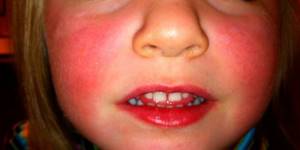
Treatment and prevention
Treatment of facial redness isolated is incorrect. It is necessary to find the cause of excessive blood flow. To do this, you need to consult a specialist who will prescribe the necessary tests and objective studies.
Elimination of the true cause: hypertension, skin disease, antimicrobial therapy and cosmetic procedures, detoxification measures or antiallergic treatment - all this will help bring the complexion to a normal state and relieve its owner from the complexes associated with this phenomenon.
As preventive measures, you should avoid excessive physical activity, treat skin diseases in a timely manner, preventing them from spreading over a large area, eat right, and not expose yourself to the harmful effects of alcohol and nicotine.
Treatment for redness on the face
Red spots can be removed using etiotropic or symptomatic therapy. The first option is aimed at eliminating the cause of redness. If this is a pathology of internal organs, it is necessary to begin treatment. In this case, the disappearance of redness will indicate recovery. If the cause is a psychological factor, it is necessary to undergo a course of psychotherapy or do exercises aimed at stabilizing the nervous system. You can reduce the aggressive effects of the external environment using protective cosmetics.
Symptomatic treatment is aimed at reducing the intensity of redness. This method is resorted to if it is not possible to get rid of the pathological cause, so the effect does not last long. For this purpose, they use special cosmetics, aloe juice, and resort to washing with cold water.
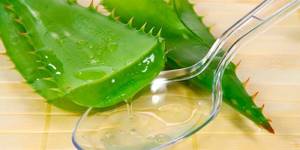
Skin care rules and nutrition
You can avoid red spots on the face and reduce the severity of their manifestation with the help of proper nutrition and proper skin care. For this purpose, you must perform the following actions:
- wash only with warm water, the temperature of which ranges from 32–34 °C;
- Do not rub your face with a towel after washing, but gently blot it with napkins;
- Apply cream, tonic and other cosmetics with light patting movements, avoiding vigorous rubbing;
- do not sit in a hot bath for a long time, refuse baths and saunas;
- do not apply hot masks to your face;
- Avoid using aggressive scrubs, alcohol lotions, scented gels and soaps;
- to clean the epidermis and remove makeup, use soft, fragrance-free preparations;
- Apply a high-quality moisturizer to the skin in the morning, and a nourishing cream in the evening after cleansing;
- stop smoking;
- if necessary, you can use a concealer (special corrector) to mask the redness.

Human health largely depends on the food he eats. After food is digested in the digestive tract, the elements released from it enter the blood and participate in metabolic processes. For this reason, low-quality products cause harm to the body, including harm to the skin, causing a response on its part in the form of redness, rash, and itching. To avoid such manifestations, it is necessary to exclude from the diet or significantly limit the use of:
- strong tea;
- coffee;
- alcohol;
- fried, sweet, spicy foods;
- spicy food;
- baking;
- sweets, chocolate;
- fast food.

Salon treatments
Salon procedures will help eliminate facial redness. To this end, the following measures are resorted to:
- superficial chemical peeling, which removes the top layer of the epidermis;
- cryomassage - a treatment method that involves combining the effects of cold on the skin with massage movements;
- mechanical cleansing and masks - help get rid of acne, inflammation, peeling;
- laser therapy or electrocoagulation – eliminates spider veins from the skin;
- mesotherapy - exposure to the middle layer of the dermis with active substances;
- biorevitalization – saturation of the deep layers of the skin with nutrients (drugs are administered by injection).
If redness is caused by pathologies of internal organs, the effect of salon procedures will be short-lived. How long it will last depends on the cause of skin coloring, general health, care of the epidermis, and the presence of chronic diseases.

Pharmacy products
You can get rid of redness using pharmaceutical ointments. Among them, the following drugs are worth highlighting:
- Fenistil-Gel – relieves swelling, irritation, itching;
- Gistan – eliminates irritation;
- Boromenthol – characterized by a cooling effect, refreshes the skin, relieves redness and itching;
- creams of the Quasix group - relieve redness, inflammation, are effective for demodicosis and rosacea;
- Troxevasin - narrows and strengthens blood vessels;
- Naphthyzin is a vasoconstrictor;
- Boro Plus - relieves acne, pimples, dryness, flaking, softens and moisturizes the skin, relieves redness;
- Bepanten - promotes tissue restoration and regeneration, regulates cellular metabolism, maintains collagen levels, eliminates inflammation.
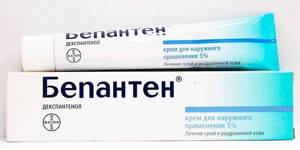
Folk recipes
Folk remedies will help eliminate redness. To get the effect of their use, a course of 8–10 procedures is required. You can prepare an effective remedy for facial redness using one of the following recipes:
- Mix chopped parsley with sour cream. Apply the mixture evenly to the face, leave for a quarter of an hour, rinse with warm water. Apply the mask every other day.
- 2 tsp. mix fat cottage cheese with 1 tsp. vegetable oil, add five drops of grapefruit juice. Apply the mixture to your face, keep for 20 minutes, rinse with cool water. The mask can be done daily.
- Brew strong black tea and cool. Soak gauze in the infusion, apply to the face, and leave for half an hour. Such compresses can be done 1-2 times a day for a long time.
- Grate the potatoes, place the pulp in cheesecloth, and squeeze out the liquid. Wipe your face with potato juice after washing 2-3 times a day.
A steam bath with hops will help soothe inflamed skin and relieve redness. To do this, pour 15 g of chopped herbs into an enamel pan, add a liter of cold water, put on low heat, and bring to a boil. Remove from the stove, bend over the broth, cover your head with a blanket or terry towel. For those with dry skin, steam for 3-4 minutes, for oily skin – ten. After the procedure, apply moisturizing milk or cream to the epidermis.

Skin tones
The shade of the skin is an important criterion for determining the color type. The wide range of shades includes dark and light tones of the cover. For example, people who have warm skin undertones display shades of warm seasons - yellow, chocolate, golden. But with a cold type, the following undertone colors will be observed - olive, beige, porcelain.
Yellowish undertone
The yellow undertone of the skin can have a variety of shades - from light to dark. This must definitely be taken into account when choosing foundation or powder; this cosmetics should create a natural look and not stand out.
Light yellow skin may appear translucent. Sometimes it can have an ivory tint. But dark tones usually turn into olive colors, which can be pale or rich.
Between the contrasts of these tones, various colors can be hidden:
- Light beige;
- Sand;
- Golden;
- Nutty with rich tints and many others.
Important! Be sure to find out the exact shade of your face, this will help you choose the right cosmetics. Typically, foundations are named after the tones of the skin (walnut, sand, golden, beige, peach).
Olive undertone
Olive undertone refers to yellowish skin tone and is part of this shade group. The color of olive fascinates with its richness and brightness. Important features of the skin of this shade include:
- Deep and rich color;
- Natural look;
- Various defects are rarely visible on its surface - age spots, freckles;
- The face has a uniform shade without sharp tints.
Pink undertone
Skin undertones with pink undertones are common. It belongs to the group of warm tones, which can be pale or bright. The main advantage is that they emphasize the dignity of the face and make it more expressive.
The pink undertone combines the following shades;
- Light pink;
- Peach;
- Porcelain;
- Beige;
- Copper with a rich tint.
Neutral undertone
Neutral skin undertones are rare. For many, it may seem complicated, because it combines several shades at once - pink, yellow, bluish. But how to choose foundations for this type?
Modern cosmetics companies offer a wide range of products that are great for neutral shades. They will allow you to balance tones with warm and cool shades.

